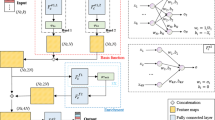Abstract
In this paper, we use a method based on radial basis functions and the collocation method for the numerical solution of a class of Volterra integral equations of the third kind, using zeros of the shifted Legendre polynomial as the collocation points. The principal benefit of this scheme is that it does not require any discretization and so it is independent of the geometry of the domains and can thus be applied to the solution of various kinds of integral equations. The procedure is more flexible for the majority of classes of Volterra integral equations of the third kind. The construction of the suggested technique has been introduced. The convergence analysis of the presented method is investigated. Finally, certain numerical examples are included to show the accuracy and efficiency of the new technique. The numerical results obtained and their comparison with other methods demonstrate the reliability of this method. Our proposed method gives acceptable accuracy with a small use of data, which also reduces the computational costs.
























Similar content being viewed by others
Data availability
Not applicable.
References
Allaei SS, Yang Z-W, Brunner H (2015) Existence, uniqueness and regularity of solutions for a class of third-kind Volterra integral equations. J Integr Equ Appl 27:325–342
Allaei SS, Yang Z-W, Brunner H (2017) Collocation methods for third-kind VIEs. IMA J Numer Anal 37(3):1104–1124
Aourir E, Izem N, Laeli Dastjerdi H (2024) A computational approach for solving third kind VIEs by collocation method based on radial basis functions. J Comput Appl Math 440:115636
Atkinson KE (1993) The discrete collocation method for nonlinear integral equations. IMA J Numer Anal 13(2):195–213
Atkinson KE (1997) The numerical solution of integral equations of the second kind. Cambridge University Press, Cambridge
Atkinson KE, Potra FA (1987) Projection and iterated projection methods for nonlinear integral equations. SIAM J Numer Anal 24(6):1352–1373
Brunner H (2004) Collocation methods for Volterra integral and related functional differential equations. Cambridge University Press, Cambridge
Brunner H (2017) Volterra integral equations: an introduction to theory and applications. Cambridge University Press, Cambridge
Brunner H, Pedas A, Vainikko G (1999) The piecewise polynomial collocation method for nonlinear weakly singular Volterra equations. Math Comput 68:1079–1095
Buhmann MD (2003) Radial basis functions: theory and implementations. Cambridge University Press, Cambridge
Dastjerdi HL, Shayanfard F (2021) A numerical method for the solution of nonlinear Volterra Hammerstein integral equations of the third-kind. Appl Numer Math 170:353–363
Fasshauer GE (2002) Newton iteration with multiquadrics for the solution of nonlinear PDEs. Comput Math Appl 43(3–5):423–438
Fasshauer G (2006) Meshfree methods. In: Rieth M, Schommers W (eds) Handbook of theoretical and computational nanotechnology, vol 2. American Scientific Publishers, Valencia
Franke R (1982) Scattered data interpolation: tests of some methods. Math Comput 38(157):181–200
Hardy RL (1971) Multiquadric equations of topography and other irregular surfaces. J Geophys Res 76(8):1905–1915
Mirzaei D, Dehghan M (2010) A meshless based method for solution of integral equations. Appl Numer Math 60(3):245–262
Schoenberg IJ (1938) Metric spaces and completely monotone functions. Ann Math 39:811–841
Shayanfard F, Dastjerdi HL, Ghaini FM (2019) A numerical method for solving Volterra integral equations of the third kind by multistep collocation method. Comput Appl Math 38:1–13
Song H, Yang Z, Brunner H (2019) Analysis of collocation methods for nonlinear Volterra integral equations of the third kind. Calcolo 56:1–29
Song H, Yang Z, Xiao Y (2022) Super-convergence analysis of collocation methods for linear and nonlinear third-kind Volterra integral equations with non-compact operators. Appl Math Comput 412:126562
Vainikko G (2009) Cordial Volterra integral equations 1. Numer Funct Anal Optim 30(9–10):1145–1172
Vainikko G (2010a) Cordial Volterra integral equations 2. Numer Funct Anal Optim 31(2):191–219
Vainikko G (2010b) Spline collocation-interpolation method for linear and nonlinear cordial Volterra integral equations. Numer Funct Anal Optim 32(1):83–109
Wendland H (2005) Scattered data approximation. Cambridge University Press, Cambridge
Yang ZW (2015) Second-kind linear Volterra integral equations with noncompact operators. Numer Funct Anal Optim 36:104–131
Acknowledgements
The authors are very grateful to the reviewers for their valuable comments and suggestions which have improved the paper.
Funding
No funding was received for conducting this study.
Author information
Authors and Affiliations
Corresponding author
Ethics declarations
Conflict of interest
The authors declare no conflict of interest to announce.
Ethical approval
Not applicable.
Additional information
Communicated by Hui Liang.
Publisher's Note
Springer Nature remains neutral with regard to jurisdictional claims in published maps and institutional affiliations.
Rights and permissions
Springer Nature or its licensor (e.g. a society or other partner) holds exclusive rights to this article under a publishing agreement with the author(s) or other rightsholder(s); author self-archiving of the accepted manuscript version of this article is solely governed by the terms of such publishing agreement and applicable law.
About this article
Cite this article
Aourir, E., Izem, N. & Dastjerdi, H.L. Numerical solutions of a class of linear and nonlinear Volterra integral equations of the third kind using collocation method based on radial basis functions. Comp. Appl. Math. 43, 117 (2024). https://doi.org/10.1007/s40314-024-02630-9
Received:
Revised:
Accepted:
Published:
DOI: https://doi.org/10.1007/s40314-024-02630-9
Keywords
- Radial basis functions
- Meshless methods
- Third kind Volterra integral equations
- Numerical integration
- Collocation method
- Error analysis




